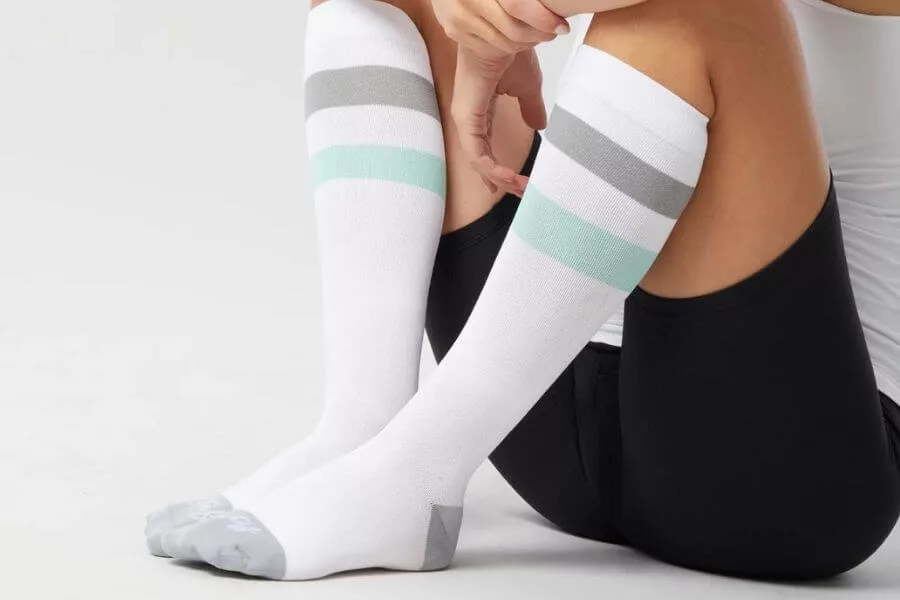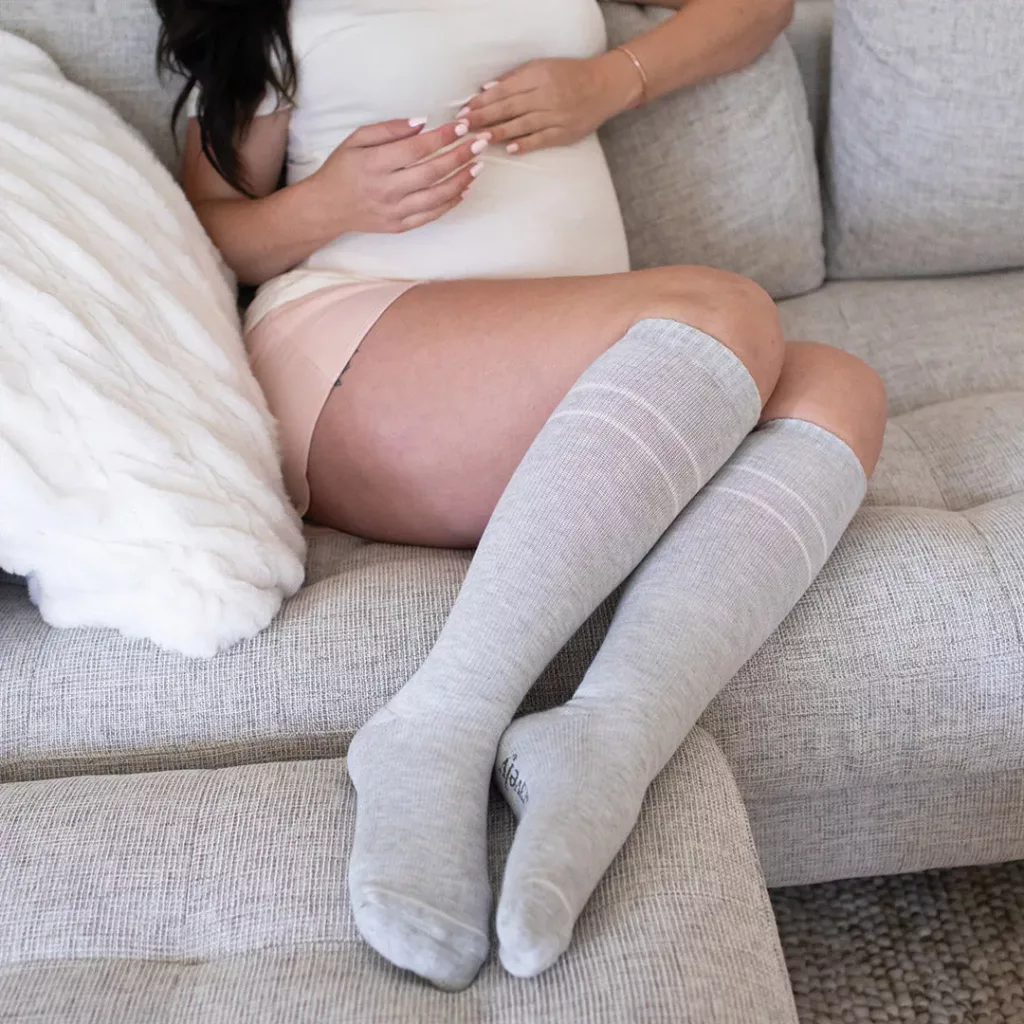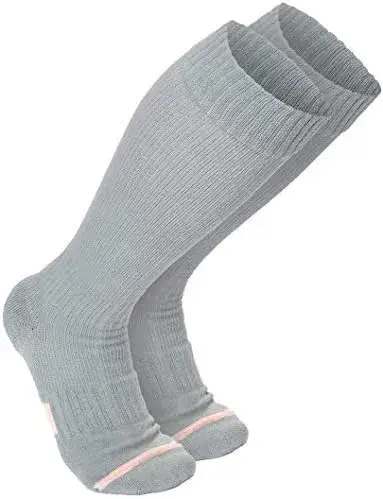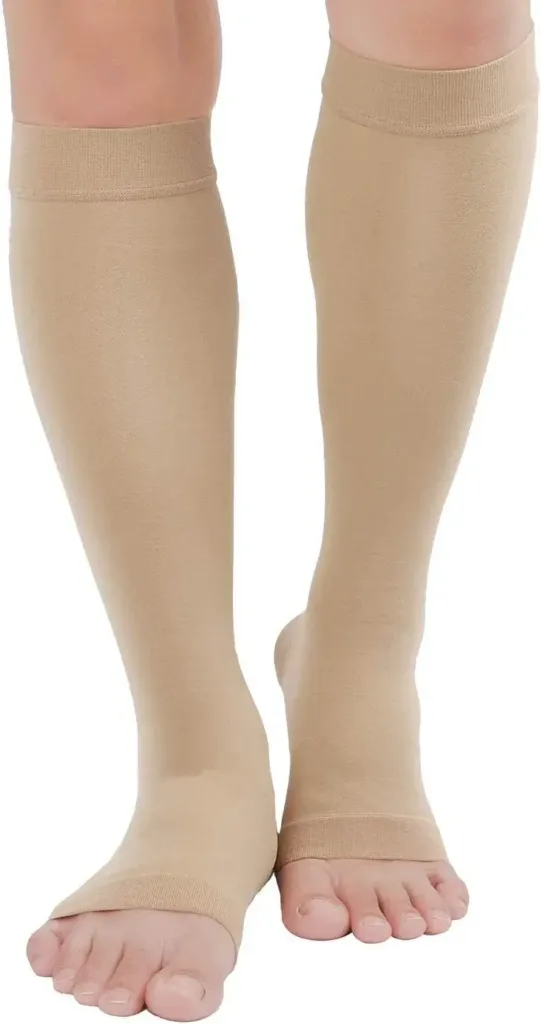By now, you may have heard about the concept of wearing maternity compression socks during both pregnancy and the postpartum period. Fashion aspect aside, these can be an absolute gamechanger if you’re experiencing swelling and discomfort during pregnancy. If you’re curious about why you should look into getting your own compression socks, what’s available, and our top picks for the best maternity compression socks, keep reading. We’re here to provide you with valuable insights and recommendations that will help you make informed choices for your pregnancy and postpartum comfort.
Topics
Why maternity compression socks matter during pregnancy and postpartum
Compression socks help relieve and soothe a number of discomforts we face during pregnancy and postpartum. Some of the reasons you might want to start looking into the best maternity compression socks are:
- Reducing swelling: Many women experience fluid retention in their legs, ankles, feet, and fingers during pregnancy. This happens because the body retains fluid to prepare for the growth of the baby and to allow the joints and tissues to expand for delivery, as explained by the American Pregnancy Association.Compression socks help improve blood circulation by applying gentle pressure to the legs, which can minimize discomfort.
- Alleviating varicose veins symptoms: We are at a higher risk of developing varicose veins during pregnancy due to the increased blood flow in our bodies and higher levels of progesterone, which cause the blood vessel walls to relax and decrease valve function, as stated by the Cleveland Clinic. Having said this, compression socks are not a cure for varicose veins but it can help alleviate symptoms and in some cases, prevent them.
- Alleviating leg discomfort: We’ve experienced pregnancy, including swelling, cramps, and aches. Compression stockings can make these discomforts more bearable by supporting your muscles and improving blood circulation.
- Preventing Deep Vein Thrombosis (DVT): While not very common, being pregnant can raise your risk of a DVT, and this risk goes up after giving birth, as explained by The Royal College of Obstetricians & Gynecologists. Compression socks can lower your risks of getting DVT, according to WebMD.
- Supporting Postpartum recovery: Not only are maternity compression socks helpful during pregnancy, but they can also be helpful after delivery. Women may continue to have swelling and discomfort in their legs after having birth. By increasing circulation and decreasing postpartum edema, compression stockings can help with recovery.
- General comfort: Women may experience weariness and discomfort throughout pregnancy, especially in those last few months. Women can feel more at peace during this time by wearing maternity compression socks, which offer a cozy and supportive alternative.
- Improving energy levels: Maternity compression socks can enhance energy levels and a general sense of well-being during pregnancy and postpartum recovery by easing discomfort and fostering better blood flow, according to Healthline.
Types of maternity compression socks
There are three types of compression socks, including graduated or medical compression socks, antiembolism stockings, and nonmedical support hosiery. Let’s explain each one of them further:
- Graduated or medical compression socks: These are primarily used for chronic venous disease and edema, putting the highest pressure at the ankle, gradually decreasing compression as they go up the leg. These stockings meet strict medical and technical standards while being designed for ambulatory patients.
- Antiembolism stockings: These provide gradient compression to reduce deep vein thrombosis risk. They are designed for bedridden patients and differ from graduated compression hosiery, which has varying compression levels.
- Nonmedical support hosiery: These offer relief for tired legs with uniform compression, less strict regulations, and no prescription requirement.
Choosing the right size for maternity compression socks
Compression socks or stockings are meant to feel nice and snug but never too tight to cause any type of pain. They have different pressure levels measured in mmHg, and the higher the mmHg, the tighter they are.
You can go with the same size as your regular socks size, but we advise you to read the labels or check the chart size for a more accurate size. When it comes to the pressure, it is recommended to opt for a light to moderate pressure (20-30 mmHg).
What to consider when buying maternity compression socks
Compression level: It is recommended to use moderate compression during pregnancy, which falls between 20-30 mmHg.
Size and fit: Ensure that your legs feel comfortably snug without the socks poking into your skin.
Material: Opt for a breathable fabric, especially for those hot days or the last months of pregnancy when you might feel hot even during winter.
Maintenance: Make sure you don’t get high-maintenance socks, as you’ll be busy creating life inside you and managing your own life, and we know the last thing you’ll want is to have to wash something specially.
Budget: There are compression socks available in various price ranges. Make sure you know how much you are willing to spend and that what you get falls within your budget. This is money well spent!
Here are our top picks for maternity compression socks
- Compression gradually decreases from ankle to sock opening, with cushioned soles for maximum comfort.
- Pressure: 20-30 mmHg graduated compression.
- Fabric: Made of a blend of 60% Viscose from Bamboo, 15% Spandex, 23% Elastane and 2% Nylon.
- Specially designed for pregnancy. It is recommended to put them on in the morning for best results.
- Fabric: Made of a blend of 48% Recycled Polyamide, 44% Organic Cotton, and 8% Elastane.
- Great for pregnancy, new mamas, and sports.
- Pressure: 25-30 mmHG at the foot and ankle, 15-20 mmHG in the middle of the leg and calf, and 10-15 mmHG under the knee.
- Fabric: Made of a blend of Cotton, Rayon.
- These can be worn at any stage of pregnancy and postpartum, and beyond.
- Pressure: 15-20 mmHg graduated compression.
- Fabric: Made of a blend of 76.6% Nylon and 23.4% Spandex.
- These can be worn at any stage of pregnancy and postpartum.
- Pressure: 15-20 mmHg graduated compression.
- Fabric: Made of a blend of 70% Nylon, 20% Elastane, 5% Polyester and 5% Spandex.
FAQs
How to wear maternity compression socks correctly?
Preferably, put them on in the morning as soon as you wake up , when you’re not as swollen yet, and while you’re still laying down. Put them inside out, insert your foot first, and then roll the socks all the way up. As we mentioned before, they’re meant to be tight in a nice way, not in a way that could hurt.
When should I start wearing maternity compression socks during pregnancy?
We advise you to consult your healthcare provider for your specific situation, but in general, you could start wearing them as soon as you notice your legs starting to swell or feel fatigued. It’s a good idea to wear them on the plane if you are planning to travel.
Can I wear maternity compression socks at night while sleeping?
While you can, it’s not necessary, according to the Cleveland Clinic. It can also be annoying on your skin to have them on all the time. So it’s a good idea to take a break from them while you sleep.
Should I wear maternity compression socks for travel during pregnancy?
Once your healthcare provider has given you the green light to travel, it’s not a bad idea to take your compression socks with you. Due to changes in cabin pressure and air circulation, your legs might tend to swell more on a plane.
Can I wear maternity compression socks postpartum for recovery?
It is strongly recommended, as you may still experience swelling after giving birth, especially during the first week of the fourth trimester. If you have undergone a c-section, the hospital is likely to recommend the use of compression socks to enhance circulation and prevent the formation of blood clots.
How long should I wear maternity compression socks each day?
Most compression socks can be worn throughout the entire day, but be sure to carefully read the manufacturer’s instructions and consider your personal comfort level.
Are there any situations where I shouldn’t wear maternity compression socks?
There are several medical conditions for which wearing compression socks may not be suitable. It is advisable to consult with your healthcare provider before purchasing them.
How do I incorporate maternity compression socks into my daily wardrobe?
Compression socks can be worn under longer skirts, pants or even on their own. At the end of the day, wearing compression socks isn’t just good for your health but potentially necessary. There is no need to feel embarrassed or ashamed wearing them.




